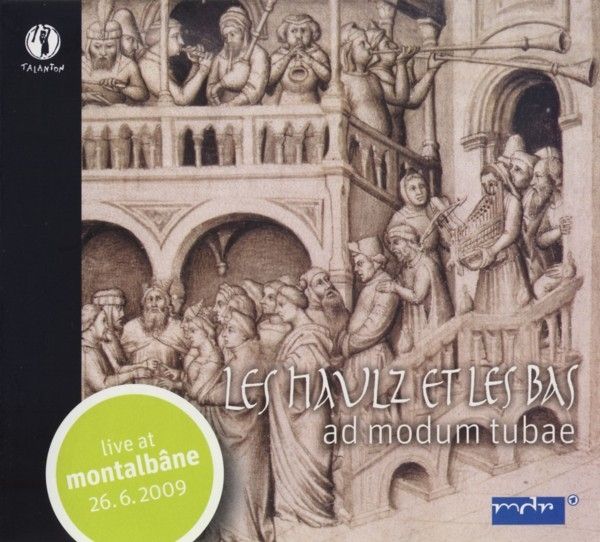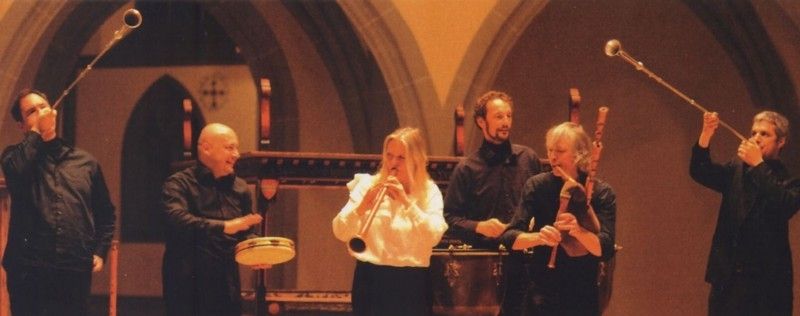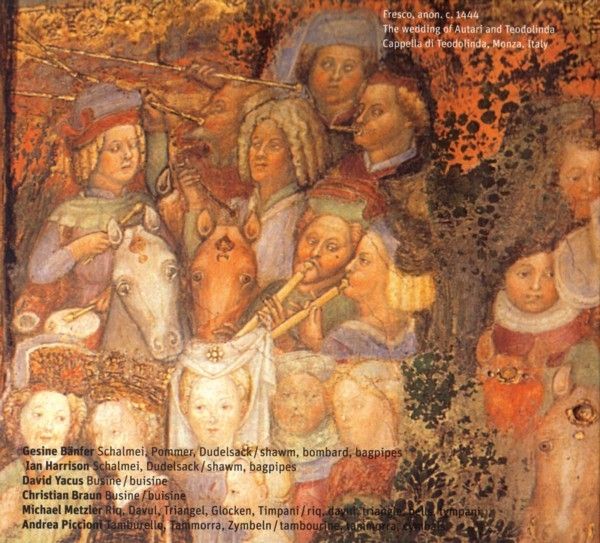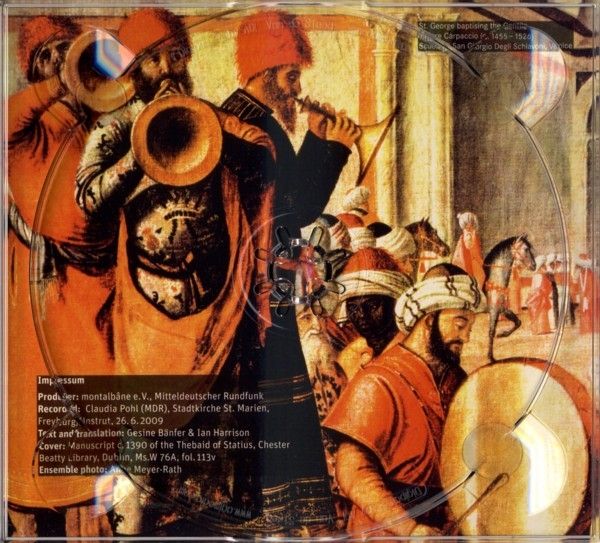»ad modum tubae«
Les Haulz et les Bas

medieval.org
Talanton TAL 90007
© Talanton 2011
2012
1. Introitus de
tuba | David Yacus [2:19]
2. Mönch von SALZBURG, c.1400. Dy Trumpet [1:04]
3. Guillaume Du FAY, 1400-1476. Gloria ad modum Tubae
[3:47]
4 - [9:19]
Guillaume Du FAY. Navré
je suis
Puis fortuna |
an. Italian c. 1470
Guillaume Du FAY. Se
la face ay pale
5. Guillaume Du FAY. Ce jour de l'an
[3:16]
6. Chansonetta
Tedesca | an. Italian c. 1400 [3:26]
7. Trotto |
an., Italian c. 1400 [3:43]
8. Guillaume de MACHAUT, 1300-1377. Douce Dame Jolie
[4:46]
9 - [12:18]
La Manfredina |
an. Italian c. 1400
Improvisation |
Michael Metzler
La Capirese |
trad. Puglia, arr. Andrea Piccioni
10. Giovanni Ambrosio DALZA, Venice 1506. Piva [4:00]
11. La danse de
cleves | an. late 15th c. [5:56]
12. [5:32]
Pastorella |
trad. Italian
Alif ya soultani |
trad. Turkish
13. Naslenkino Horo |
trad. Bulgarian [2:46]
14. Ali UFKI, 1610-c.1675. Neva cheng-i-harbi
[2:38]

Les Haulz et les Bas
Gesine Bänfer
Schalmei, Pommer, Dudelsack / shawm, bombard, bagpipes
Ian Harrison
Schalmei, Dudelsack / shawm, bagpipes
David Yacus
Busine / buisine
Christian Braun
Busine / buisine
Michael Metzler
Riq, Davul, Triangel, Glocken, Timpani / riq, davul, triangle,
bells, tympani
Andrea Piccioni
Tamburello, Tammorra, Zymbeln / tambourine, tammorra, cymbals
Producer:
montalbâne e.V., Mitteldeutscher Rundfunk
Recorded Claudia Pohl (MDR),
Stadtkirche St. Marien, FreyburgInstrut, 26.6.2009
Text and translation: Gesine Bänfer & Ian Harrison
Coyer: Manuscript c.1390 of the Thebaid of Statius, Chester,
Beatty Library, Dublin, Ms.W 76A, fol. 113v
Ensemble photo: Anne Meyer-Rath

A pair of long straight trumpets, shawms, bagpipes and percussion: this
type of loud band is depicted in many European works of art from the
late middle ages. Poets praised them in songs and poems. Payment
Records show that they were employed by rulers and by cities, that
instruments were sold and players transferred from one court to another.
Known in the West as the alta and in the East as the naubat
this ensemble came to Europe from the Far and Middle East along the
ancient trade routes. In Morocco, Usbekistan, Brunei and in many more
places the naubat can still be heared. The shawms and bagpipes
symbolised the party or feast, the trumpet power and state, and the
percussion the dance. Thus this ensemble has played since time
immemorial at significant moments of human life: baptism, marriage and
death. Ottoman Sultans took the naubat with them into battle;
European kings employed altas to accompany them on their
travels and announce their presence. The sound of the loud instruments
greeted the day at sunrise and signalled its end at sunset. Naubat
became une aubade, and the Arabic trumpet, the nafir
gave its name to the fanfare.
The title of this recording is taken from the Gloria ad modum tubae
— the "Gloria in trumpet style" by Guillaume Dufay. With its two
voices playable on natural trumpets this piece gives a tantalising
glimpse of the possible sound of a mediaeval wind ensemble. The
marriage of the shawm and the trumpet in polyphonic music in mediaeval
Europe gave rise to a tradition of wind music which lives on today in
symphony orchestras, jazz combos, circus bands etc. Drawing inspiration
from living musical cultures from east and west LES HAULZ ET LES BAS
reconstructs the music of the 14th and 15th centuries in its original
instrumentation.
Formed in 1993 LES HAULZ ET LES BAS is one of Europe's most active alta
capella ensembles. They were prizewinners at the Bruges Early Music
Festival, have performed and broadcast throughout Europe and have given
lectures and master classes at the Universities of Oxford and London,
the Royal Conservatory, The Hague and at the Schola Cantorum
Basiliensis.
Instruments
Straight trumpets (buisines) by Christian Bosch and David Yacus
(after a 14th-century original found in the Thames in Billingsgate)
Shawms by Bernhard Schermer and John Hanchett (after
16th-century originals)
Bagpipes by Anton Varela and Gesine Bänfer (trad. Gallician)
Tammorra by Nicolas Fuxius und Andrea Piccioni (trad. Italian)
Tambourines by Bruno Spagna and Stefano Cicconcelli (trad.
Italian)
Bells by Michael Metzler
Tabor by Norbert Eckermann
Timpani anon., French(?), 18th cent. (this type of instrument
appears in pictures from the 15th century)

Ein Paar langer gerader Trompeten, Schalmeien, Dudelsäcke und
Perkussion — dieses Ensemble, bestehend aus lauten
Blasinstrumenten, wurde in zahlreichen europäischen Kunstwerken
des 14. und 15. Jahrhunderts abgebildet. Dichter lobten die laute Band
des Mittelalters in Liedern und Gedichten. Belege zeigen, dass sie von
Fürsten und Städten besoldet waren, dass Instrumente verkauft
und Spieler von einem Hof zum anderen transferiert wurden.
Im Westen hieß dieses Ensemble alta und im Osten naubat.
Es kam entlang der alten Handelsstraßen vom Fernen und Mittleren
Osten nach Europa. In Marokko, Usbekistan, Brunei und in vielen anderen
Orten kann die Naubat noch gehört werden. Die Schalmeien und
Dudelsäcke symbolisieren festliche Rituale, die Trompeten die
Macht und den Staat sowie die Perkussionsinstrumente den Tanz. Darum
spielte dieses Ensemble seit jeher in allen Übergangsritualen des
Menschenlebens wie Taufe, Hochzeit und Tod eine wichtige Rolle.
Osmanische Sultane brachten die Naubat mit in die Schlacht;
europäische Könige stellten alta Ensembles ein, die sie bei
ihren Reisen begleiteten sollten, um die Ankunft des Herrschers
lautstark und klangvoll anzukündigen. Der Klang der lauten
Instrumente begrüßte den Tag bei Sonnenaufgang und
signalisierte sein Ende bei Abenddämmerung. Die ursprünglich
arabischen Begriffe leben noch heute im westeuropäischen
Sprachgebrauch weiter. Aus naubat wurde une aubaude
(französisch für Tagelied), die arabische Trompete nafir
bildete den Ursprung für unser Wort Fanfare.
Der Titel dieser Aufnahme wurde von dem — dem »Gloria im
Stil der Trompete« von Guillaume Dufay übernommen. Mit
seinen zwei Stimmen, die auf Naturtrompeten spielbar sind, gibt uns
dieses Stück faszinierende Zeugnisse vom Klang eines
mittelalterlichen Bläserensembles. Durch die Hochzeit von Schalmei
und Trompete im mittelalterlichen Europa entstand im Alta-Ensemble eine
einzigartige mehrstimmige Bläsermusik, deren Tradition noch heute
in den Symphonieorchestern, im Jazz, in den Zirkuskapellen etc.
fortlebt. LES HAULZ ET LES BAS lässt sich von den lebendigen
Musikkulturen in Ost und West inspirieren und rekonstruieren die
Klangwelt der Musik des 14. und 15. Jahrhunderts in ihrer
Originalbesetzung.
LES HAULZ ET LES BAS wurde 1993 gegründet und ist nach wie vor
eines der aktivsten Alta-Capella-Ensembles Europas. Die Musiker sind
Preisträger des Festivals der Alten Musik in Brügge, spielten
in ganz Europa Konzerte, wirkten an Rundfunkproduktionen mit und
hielten Vorlesungen sowie Meisterkurse an den Universitäten von
Oxford und London, dem Königlichen Konservatorium in Den Haag und
an der Schola Cantorum Basiliensis.
Instrumente
Gerade Trompeten (Businen): Christian Bosch und David Yacus,
nach einem Original aus dem 14. Jh. (gefunden in der Themse in
London/Billingsgate)
Schalmeien: Bernhard Schermer
Pommer: John Hanchett, nach Originalen des 16. Jh.
Dudelsäcke: Anton Vareia und Gesine Bänfer, trad.
galizisch
Tammorra: Nicolas Fuxius und Andrea Piccioni, trad. italienisch
Tamburelli: Bruno Spagna und Stefano Cicconcelli, trad.
italienisch
Glocken: Michael Metzler
Tabor: Norbert Eckermann
Timpani: anonym, franz.(?), 18. Jh. (in dieser Form bereits auf
Bildern des 15. Jh. dargestellt)





